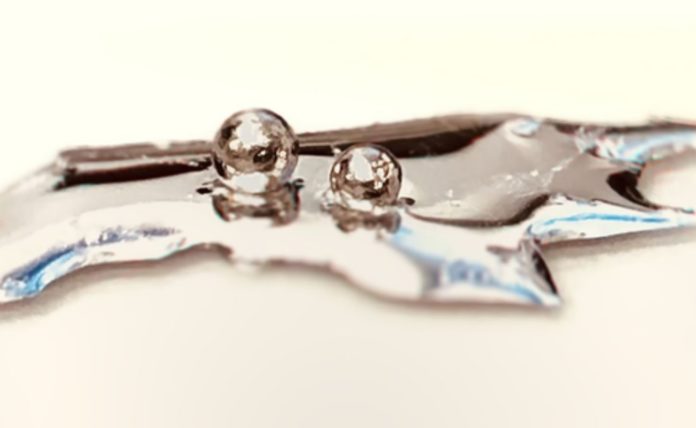Platinum is an excellent catalyst (the trigger for chemical processes), but it is not extensively employed in the industry due to its high cost. The majority of platinum-based catalysis systems have substantial continuous energy expenditures.
Now, scientists in Australia have found a way to use tiny amounts of liquid platinum to create cheap and highly effective chemical reactions at low temperatures. This opens the door for major reductions in emissions in industries that are important to the economy.
When mixed with liquid gallium, the amount of platinum needed is small enough to significantly increase the earth’s supply of this valuable metal. This could lead to more sustainable ways to reduce CO2, make ammonia for fertilizer, and make green fuel cells, among many other uses in the chemical industries.
When it comes to the potential of these catalytic systems, these findings, which focus on platinum, are merely a drop in the liquid metal ocean. With this process expanded, there might be over 1,000 potential combinations of ingredients for over 1,000 different reactions.
The findings were published in the journal Nature Chemistry today.
Platinum is an excellent catalyst (the trigger for chemical processes), but it is not extensively employed in the industry due to its high cost. The majority of platinum-based catalysis systems have substantial continuous energy expenditures.
The melting point of platinum is normally 1,700°C. In a carbon-based catalytic system, there needs to be roughly 10% platinum when it’s employed in a solid-state for industrial purposes.
When trying to manufacture components and goods for commercial sale, this is an unaffordable ratio.
That could change in the future, thanks to researchers at UNSW Sydney and RMIT University who discovered a way to use little amounts of platinum to trigger powerful reactions without using a lot of energy.
The team, which included members of the ARC Centre of Excellence in Exciton Science and the ARC Centre of Excellence in Future Low Energy Technologies, coupled the platinum with liquid gallium, which has a melting point of just 29.8°C, or room temperature on a warm day. Platinum becomes soluble when mixed with gallium. In other words, it melts without the use of a massive industrial furnace.
Processing at a high temperature is only necessary at the beginning of this mechanism when platinum is dissolved in gallium to establish the catalytic system. Even then, the temperature is only around 300°C for an hour or two, far from the constant high temperatures required in industrial-scale chemical engineering.
Dr. Jianbo Tang of UNSW, a contributing author, compared it to a blacksmith utilizing a hot forge to create long-lasting equipment.
“If you’re working with iron and steel, you have to heat it up to make a tool, but you have the tool and you never have to heat it up again,” he explained.
“Other people have tried this approach but they have to run their catalysis systems at very high temperatures all the time.”
For the researchers to make a good catalyst, they had to use less than 0.0001% platinum to gallium. Most notably, the resulting system was almost 1,000 times more efficient than its solid-state competitor (the one that needed to be around 10 percent expensive platinum to work)
The benefits don’t end there: it’s also more reliable because it’s a liquid-based technology. Solid-state catalytic systems silt up and stop operating over time. That isn’t an issue here. The liquid mechanism, similar to a water feature with a built-in fountain, constantly refreshes itself, self-regulating its efficacy over time and avoiding the catalytic equivalent of pond scum forming on the surface.
“From 2011, scientists were able to miniaturize catalyst systems down to the atomic level of the active metals. To keep the single atoms separated from each other,” noted lead author Dr. Md. Arifur Rahim of UNSW Sydney, adding “the conventional systems require solid matrices (such as graphene or metal oxide) to stabilize them. I thought, why not using a liquid matrix instead and see what happens.”
“The catalytic atoms anchored onto a solid matrix are immobile. We have added mobility to the catalytic atoms at low temperature by using a liquid gallium matrix.”
The mechanism is also adaptable enough to accomplish both oxidation and reduction reactions, in which oxygen is added to or removed from a molecule.
To comprehend these astonishing results, the UNSW experimentalists had to overcome several mysteries. Their RMIT colleagues, led by Professor Salvy Russo, were able to determine that platinum never becomes solid, right down to the level of individual atoms, using advanced computational chemistry and modeling.
Dr. Nastaran Meftahi, Exciton Science Research Fellow, explained the relevance of her RMIT team’s modeling work.
“What we found is the two platinum atoms never came into contact with each other,” she explained.
“They were always separated by gallium atoms. There is no solid platinum forming in this system. It’s always atomically dispersed within the gallium. That’s really cool and it’s what we found with the modelling, which is very difficult to observe directly through experiments.”
Surprisingly, gallium is the one that initiates the necessary chemical reaction, functioning under the influence of platinum atoms in close proximity.
“The platinum is actually a little bit below the surface and it’s activating the gallium atoms around it,” Exciton Science Associate Investigator Dr Andrew Christofferson of RMIT emphasized how innovative these results are. “The magic is happening on the gallium under the influence of platinum.
“But without the platinum there, it doesn’t happen. This is completely different from any other catalysis anyone has shown, that I’m aware of. And this is something that can only have been shown through the modelling.”
Image Credit: Dr Md. Arifur Rahim, UNSW Sydney
You were reading: New ‘cool’ Catalyst Can Extend Platinum Reserves On Earth – Scientists
